
Treatment of the Seriously Obese Patient
Book details
Summary
Description
An ideal resource for practitioners working with individuals who are seriously overweight, this unique and timely volume takes a multidisciplinary approach to assessment and treatment. With 21 chapters written by experts from fields including clinical psychology, medicine, exercise physiology, nutrition, and metabolism, the book examines the many health risks of obesity, the goals and results of treatment, and findings concerning possible adverse effects of stringent dieting.
The volume opens with guidelines to help practitioners assess the health and mortality risks of overweight patients. Addressing the problem of integrating information about important risk-modifying factors, it presents a classification of obesity, an overview of current therapies, and a discussion on the use of very low calorie diets. The biological response to caloric restriction is explored in five chapters that cover methods of measuring body composition and the changes that occur during therapeutic weight loss; the animal literature on caloric restriction, body composition, and organ function; the fatal cardiac arrhythmias that may occur in obese consumers of liquid protein diets; and the effects of dieting and weight loss on energy expenditure.
Chapters on the consequences of therapeutic weight loss reveal that a reduction in initial weight of as little as 10% is frequently sufficient to improve or control the adverse health effects of obesity. They also outline the potentially unique advantages of using very low calorie diets with obese Type II diabetics, describe the psychological changes that can be anticipated when an obese patient loses weight, and discuss the timely issue of binge eating in the obese.
Providing a multidisciplinary, hands-on approach to treatment, six chapters then review the clinical use of very low calorie diets. A physician discusses the initial medical evaluation, as well as guidelines for monitoring patients throughout treatment. Psychologists describe the initial psychosocial evaluation and review behavioral interventions. A nutritionist/dietitian outlines the criteria for selecting the appropriate diet, methods of managing the refeeding period, and strategies for helping patients maintain a long-term, nutritious low fat diet. An exercise physiologist discusses the health benefits of physical activity and the special exercise needs of the seriously obese. The literature on predictors of weight loss and attrition from therapy is reviewed to help identify patients least likely to be successful. And, finally, in a chapter that will help sensitize clinicians to the daily challenges clients face, a former patient describes her experiences in losing weight in a combined program of very low calorie diet and lifestyle change.
The book's closing section examines the critical issue of maintenance of weight loss and alternative therapies. A theoretical model for relapse prevention is presented, as is a summary of six studies investigating methods for facilitating weight loss. Other chapters discuss pharmacological and surgical interventions for the massively obese individual.
Providing practitioners with new approaches for treatment and a better understanding of the nature of their patients' ongoing struggle with weight, TREATMENT OF THE SERIOUSLY OBESE PATIENT is an invaluable resource for all professionals who work with overweight individuals.


We would LOVE it if you could help us and other readers by reviewing the book
Book review



